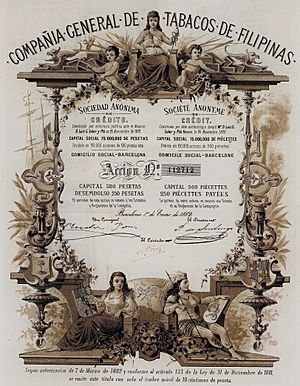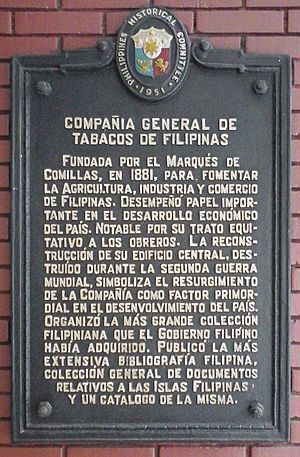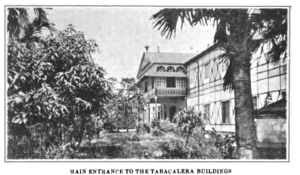Compañía General de Tabacos de Filipinas facts for kids
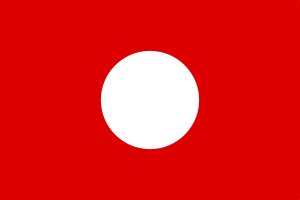
Company shipping line house flag
|
|
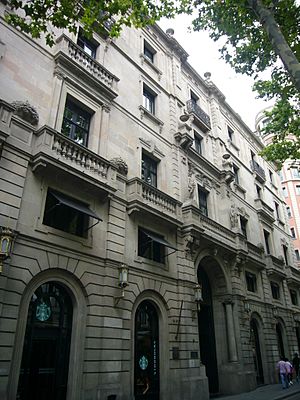
The original headquarters in Barcelona, Spain
|
|
| Sociedad Anónima | |
| Industry | Tobacco Liquor Sugar Transportation |
| Founded | 1881 |
| Founder | Antonio López, 1st Marquess of Comillas |
| Headquarters | Manila, Philippines |
|
Key people
|
Manuel Meler (Chairman) |
|
Number of employees
|
104,000 (1898) |
The Compañía General de Tabacos de Filipinas, S.A. (often called CdF) was a very important Spanish company. It was one of the biggest businesses in the world in the late 1800s and early 1900s. This company was the first private tobacco business in the Philippines.
It was started in Barcelona, Spain, in 1881 by the 1st Marquess of Comillas. Its main office was in Manila, Philippines. People in Spain sometimes called it Tabacos de Filipinas. In the Philippines, it was known as La Tabacalera.
Even though the company mostly deals with tobacco today, it used to do many other things. It had its own shipping line to move goods and people. It also built factories to grow, make, and sell tobacco from the Philippines. The company also got involved in other areas. These included making sugar and alcohol. It also worked with copra (dried coconut meat), abacá (a strong plant fiber), and maguey (another plant fiber). CdF also owned parts of companies that made electricity, provided transport, and offered insurance.
The company was owned by Spanish groups for most of its history. Between the 1950s and 1990s, it became much smaller. During this time, it sold most of its other businesses in the Philippines. It decided to focus only on trading tobacco around the world. In 2007, CdF joined with a Dutch tobacco trading company called Lippoel Leaf. They formed the CdF International Group. Then, in 2011, CdF joined again with an American tobacco trading company, Hail & Cotton. The original company still exists today as its Philippine branch.
Contents
What the Company Did
The Compañía General de Tabacos de Filipinas was involved in many different activities. It was a very busy and diverse company.
Making and Selling Tobacco
- The company grew tobacco plants.
- It made tobacco products in its factories.
- Then, it sold these tobacco products to people.
Shipping and Transport
- CdF had its own ships.
- These ships carried goods and passengers across the ocean.
- This helped the company move its products and connect different places.
Other Products and Industries
- Starting in 1892, the company began selling products from forests.
- From 1893, it also started making and selling sugar and alcohol.
- CdF was also involved in producing copra, which comes from coconuts.
- It produced abacá fiber, also known as 'Manila hemp'. This is a very strong fiber used for ropes and fabrics.
- The company also produced maguey fiber, another type of strong plant fiber.
Where the Company Operated
The company sold its products and offered its services in three main areas. These were its most important markets.
Spanish Market
- This was the market in Spain itself.
- It was called the Peninsular market.
European Market
- CdF traded with many countries in Europe.
- These included the United Kingdom, Germany, the Netherlands, and Portugal.
Asian and Oceanian Markets
- The company also operated in the Philippines.
- It traded with other parts of Asia and Oceania.
Company's Legacy
The National Historical Commission of the Philippines placed a special marker in Manila in 1951. This marker honored the company. It recognized the important part CdF played in helping the Philippines' economy grow. The marker also noted that the company treated its workers fairly.
After World War II, the company's main office was rebuilt. This rebuilding showed that the company was still a key player in the country's progress. The Compañía General de Tabacos de Filipinas also collected a very large number of historical Philippine documents and items. This collection was later bought by the Philippine Government.
See also
 In Spanish: Compañía General de Tabacos de Filipinas para niños
In Spanish: Compañía General de Tabacos de Filipinas para niños
- 1929 Barcelona International Exposition
- Compañía Transatlántica Española


